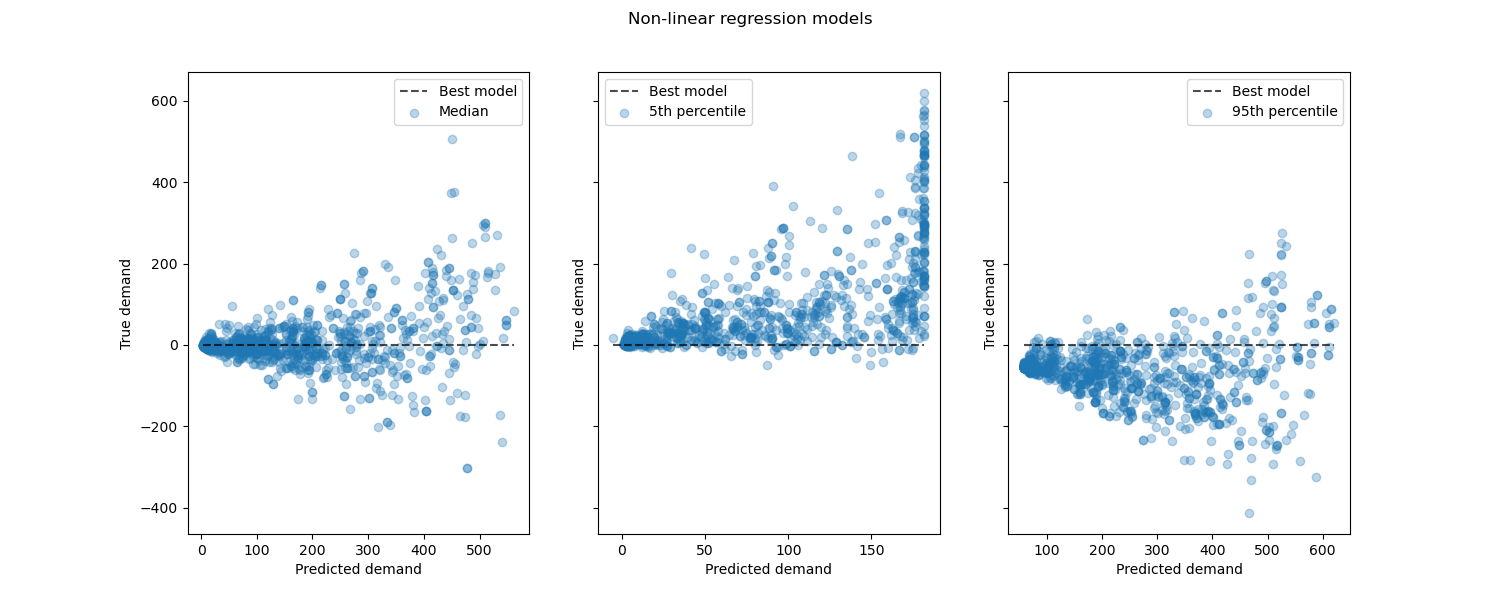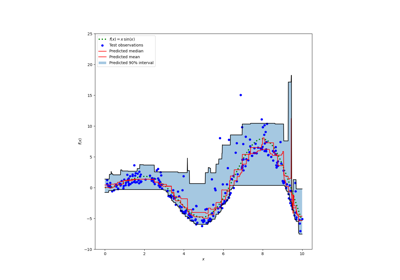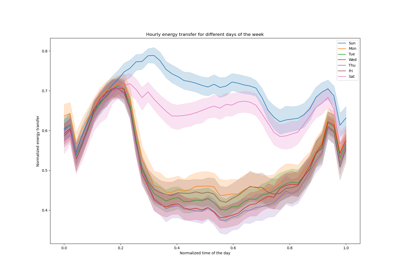注意
转到最后下载完整示例代码,或通过 JupyterLite 或 Binder 在浏览器中运行此示例。
用于时间序列预测的滞后特征#
此示例演示了如何使用 Polars 工程化的滞后特征,结合 HistGradientBoostingRegressor 在 Bike Sharing Demand 数据集上进行时间序列预测。
有关此数据集的数据探索和周期性特征工程演示,请参阅 时间相关特征工程 示例。
# Authors: The scikit-learn developers
# SPDX-License-Identifier: BSD-3-Clause
分析 Bike Sharing Demand 数据集#
我们首先从 OpenML 存储库加载数据作为原始 parquet 文件,以说明如何处理任意 parquet 文件,而不是将此步骤隐藏在 sklearn.datasets.fetch_openml 等便捷工具中。
parquet 文件的 URL 可以在 openml.org 上 id 为 44063 的 Bike Sharing Demand 数据集的 JSON 描述中找到(https://openml.org/search?type=data&status=active&id=44063)。
还提供了文件的 sha256 哈希值,以确保下载文件的完整性。
import numpy as np
import polars as pl
from sklearn.datasets import fetch_file
pl.Config.set_fmt_str_lengths(20)
bike_sharing_data_file = fetch_file(
"https://data.openml.org/datasets/0004/44063/dataset_44063.pq",
sha256="d120af76829af0d256338dc6dd4be5df4fd1f35bf3a283cab66a51c1c6abd06a",
)
bike_sharing_data_file
PosixPath('/home/circleci/scikit_learn_data/data.openml.org/datasets_0004_44063/dataset_44063.pq')
我们使用 Polars 加载 parquet 文件进行特征工程。Polars 会自动缓存重复使用的常见子表达式(例如下面的 pl.col("count").shift(1))。有关更多信息,请参阅 https://docs.polars.org.cn/user-guide/lazy/optimizations/。
df = pl.read_parquet(bike_sharing_data_file)
接下来,我们查看数据集的统计摘要,以便更好地了解我们正在处理的数据。
import polars.selectors as cs
summary = df.select(cs.numeric()).describe()
summary
让我们看看数据集中存在的季节 "fall"、"spring"、"summer" 和 "winter" 的计数,以确认它们是平衡的。
import matplotlib.pyplot as plt
df["season"].value_counts()
生成 Polars 工程化的滞后特征#
让我们考虑根据过去的骑行需求预测下一小时需求的问题。由于需求是一个连续变量,人们直觉上可能会使用任何回归模型。然而,我们没有通常的 (X_train, y_train) 数据集。相反,我们只有按时间顺序组织的需求数据 y_train。
lagged_df = df.select(
"count",
*[pl.col("count").shift(i).alias(f"lagged_count_{i}h") for i in [1, 2, 3]],
lagged_count_1d=pl.col("count").shift(24),
lagged_count_1d_1h=pl.col("count").shift(24 + 1),
lagged_count_7d=pl.col("count").shift(7 * 24),
lagged_count_7d_1h=pl.col("count").shift(7 * 24 + 1),
lagged_mean_24h=pl.col("count").shift(1).rolling_mean(24),
lagged_max_24h=pl.col("count").shift(1).rolling_max(24),
lagged_min_24h=pl.col("count").shift(1).rolling_min(24),
lagged_mean_7d=pl.col("count").shift(1).rolling_mean(7 * 24),
lagged_max_7d=pl.col("count").shift(1).rolling_max(7 * 24),
lagged_min_7d=pl.col("count").shift(1).rolling_min(7 * 24),
)
lagged_df.tail(10)
但请注意,前几行具有未定义的值,因为它们的过去是未知的。这取决于我们使用了多少滞后。
lagged_df.head(10)
我们现在可以将滞后特征分离到矩阵 X 中,并将目标变量(要预测的计数)分离到具有相同第一维度的数组 y 中。
lagged_df = lagged_df.drop_nulls()
X = lagged_df.drop("count")
y = lagged_df["count"]
print("X shape: {}\ny shape: {}".format(X.shape, y.shape))
X shape: (17210, 13)
y shape: (17210,)
下一小时骑行需求回归的朴素评估#
让我们随机拆分我们的表格数据集,以训练梯度提升回归树 (GBRT) 模型,并使用平均绝对百分比误差 (MAPE) 进行评估。如果我们的模型旨在预测(即从过去数据预测未来数据),我们不应该使用晚于测试数据的训练数据。在时间序列机器学习中,“i.i.d”(独立且同分布)假设不成立,因为数据点不是独立的并且具有时间关系。
from sklearn.ensemble import HistGradientBoostingRegressor
from sklearn.model_selection import train_test_split
X_train, X_test, y_train, y_test = train_test_split(
X, y, test_size=0.2, random_state=42
)
model = HistGradientBoostingRegressor().fit(X_train, y_train)
查看模型的性能。
from sklearn.metrics import mean_absolute_percentage_error
y_pred = model.predict(X_test)
mean_absolute_percentage_error(y_test, y_pred)
0.3889873516666431
下一小时预测的正确评估#
让我们使用考虑数据集时间结构的正确评估拆分策略来评估模型预测未来数据点的能力(以避免通过读取训练集中的滞后特征值进行作弊)。
from sklearn.model_selection import TimeSeriesSplit
ts_cv = TimeSeriesSplit(
n_splits=3, # to keep the notebook fast enough on common laptops
gap=48, # 2 days data gap between train and test
max_train_size=10000, # keep train sets of comparable sizes
test_size=3000, # for 2 or 3 digits of precision in scores
)
all_splits = list(ts_cv.split(X, y))
训练模型并根据 MAPE 评估其性能。
train_idx, test_idx = all_splits[0]
X_train, X_test = X[train_idx, :], X[test_idx, :]
y_train, y_test = y[train_idx], y[test_idx]
model = HistGradientBoostingRegressor().fit(X_train, y_train)
y_pred = model.predict(X_test)
mean_absolute_percentage_error(y_test, y_pred)
0.44300751539296973
通过洗牌训练测试拆分测量的泛化误差过于乐观。通过基于时间的拆分进行的泛化可能更能代表回归模型的真实性能。让我们通过适当的交叉验证来评估误差评估的这种可变性。
from sklearn.model_selection import cross_val_score
cv_mape_scores = -cross_val_score(
model, X, y, cv=ts_cv, scoring="neg_mean_absolute_percentage_error"
)
cv_mape_scores
array([0.44300752, 0.27772182, 0.3697178 ])
跨拆分的可变性相当大!在现实生活中,建议使用更多的拆分来更好地评估可变性。从现在开始,我们将报告平均 CV 分数及其标准差。
print(f"CV MAPE: {cv_mape_scores.mean():.3f} ± {cv_mape_scores.std():.3f}")
CV MAPE: 0.363 ± 0.068
我们可以计算评估指标和损失函数的几种组合,如下所示。
from collections import defaultdict
from sklearn.metrics import (
make_scorer,
mean_absolute_error,
mean_pinball_loss,
root_mean_squared_error,
)
from sklearn.model_selection import cross_validate
def consolidate_scores(cv_results, scores, metric):
if metric == "MAPE":
scores[metric].append(f"{value.mean():.2f} ± {value.std():.2f}")
else:
scores[metric].append(f"{value.mean():.1f} ± {value.std():.1f}")
return scores
scoring = {
"MAPE": make_scorer(mean_absolute_percentage_error),
"RMSE": make_scorer(root_mean_squared_error),
"MAE": make_scorer(mean_absolute_error),
"pinball_loss_05": make_scorer(mean_pinball_loss, alpha=0.05),
"pinball_loss_50": make_scorer(mean_pinball_loss, alpha=0.50),
"pinball_loss_95": make_scorer(mean_pinball_loss, alpha=0.95),
}
loss_functions = ["squared_error", "poisson", "absolute_error"]
scores = defaultdict(list)
for loss_func in loss_functions:
model = HistGradientBoostingRegressor(loss=loss_func)
cv_results = cross_validate(
model,
X,
y,
cv=ts_cv,
scoring=scoring,
n_jobs=2,
)
time = cv_results["fit_time"]
scores["loss"].append(loss_func)
scores["fit_time"].append(f"{time.mean():.2f} ± {time.std():.2f} s")
for key, value in cv_results.items():
if key.startswith("test_"):
metric = key.split("test_")[1]
scores = consolidate_scores(cv_results, scores, metric)
通过分位数回归建模预测不确定性#
不是像最小二乘和泊松损失那样对 \(Y|X\) 分布的期望值建模,而是可以尝试估计条件分布的分位数。
对于给定的数据点 \(x_i\),\(Y|X=x_i\) 预计是一个随机变量,因为我们期望租借数量不能从特征中 100% 准确预测。它可能受到现有滞后特征未正确捕获的其他变量的影响。例如,下一小时是否会下雨不能完全根据过去几小时的骑行租借数据来预测。这就是我们所说的随机不确定性。
分位数回归使得对该分布进行更精细的描述成为可能,而无需对其形状做出强假设。
quantile_list = [0.05, 0.5, 0.95]
for quantile in quantile_list:
model = HistGradientBoostingRegressor(loss="quantile", quantile=quantile)
cv_results = cross_validate(
model,
X,
y,
cv=ts_cv,
scoring=scoring,
n_jobs=2,
)
time = cv_results["fit_time"]
scores["fit_time"].append(f"{time.mean():.2f} ± {time.std():.2f} s")
scores["loss"].append(f"quantile {int(quantile * 100)}")
for key, value in cv_results.items():
if key.startswith("test_"):
metric = key.split("test_")[1]
scores = consolidate_scores(cv_results, scores, metric)
scores_df = pl.DataFrame(scores)
scores_df
让我们看看使每个指标最小化的损失函数。
def min_arg(col):
col_split = pl.col(col).str.split(" ")
return pl.arg_sort_by(
col_split.list.get(0).cast(pl.Float64),
col_split.list.get(2).cast(pl.Float64),
).first()
scores_df.select(
pl.col("loss").get(min_arg(col_name)).alias(col_name)
for col_name in scores_df.columns
if col_name != "loss"
)
尽管由于数据集中的方差,分数分布有所重叠,但平均 RMSE 在 loss="squared_error" 时较低,而平均 MAPE 在 loss="absolute_error" 时较低,正如预期的那样。对于分位数 5 和 95 的平均 Pinball Loss 也是如此。与 50 分位数损失对应的分数与通过最小化其他损失函数获得的分数重叠,MAE 也是如此。
对预测的定性观察#
我们现在可以可视化模型在第 5 个百分位数、中位数和第 95 个百分位数方面的性能。
all_splits = list(ts_cv.split(X, y))
train_idx, test_idx = all_splits[0]
X_train, X_test = X[train_idx, :], X[test_idx, :]
y_train, y_test = y[train_idx], y[test_idx]
max_iter = 50
gbrt_mean_poisson = HistGradientBoostingRegressor(loss="poisson", max_iter=max_iter)
gbrt_mean_poisson.fit(X_train, y_train)
mean_predictions = gbrt_mean_poisson.predict(X_test)
gbrt_median = HistGradientBoostingRegressor(
loss="quantile", quantile=0.5, max_iter=max_iter
)
gbrt_median.fit(X_train, y_train)
median_predictions = gbrt_median.predict(X_test)
gbrt_percentile_5 = HistGradientBoostingRegressor(
loss="quantile", quantile=0.05, max_iter=max_iter
)
gbrt_percentile_5.fit(X_train, y_train)
percentile_5_predictions = gbrt_percentile_5.predict(X_test)
gbrt_percentile_95 = HistGradientBoostingRegressor(
loss="quantile", quantile=0.95, max_iter=max_iter
)
gbrt_percentile_95.fit(X_train, y_train)
percentile_95_predictions = gbrt_percentile_95.predict(X_test)
我们现在可以查看回归模型做出的预测。
last_hours = slice(-96, None)
fig, ax = plt.subplots(figsize=(15, 7))
plt.title("Predictions by regression models")
ax.plot(
y_test[last_hours],
"x-",
alpha=0.2,
label="Actual demand",
color="black",
)
ax.plot(
median_predictions[last_hours],
"^-",
label="GBRT median",
)
ax.plot(
mean_predictions[last_hours],
"x-",
label="GBRT mean (Poisson)",
)
ax.fill_between(
np.arange(96),
percentile_5_predictions[last_hours],
percentile_95_predictions[last_hours],
alpha=0.3,
label="GBRT 90% interval",
)
_ = ax.legend()

这里有趣的是注意到 5% 和 95% 百分位数估计值之间的蓝色区域宽度随一天中的时间而变化。
在晚上,蓝色区域要窄得多:这对模型非常确定租借数量会很少。而且这些似乎是正确的,因为实际需求保持在该蓝色区域内。
在白天,蓝色区域要宽得多:不确定性增加,可能是因为天气变化很大,尤其是在周末,这可能产生非常大的影响。
我们还可以看到,在工作日期间,通勤模式在 5% 和 95% 估计中仍然可见。
最后,预计有 10% 的时间,实际需求不在 5% 和 95% 百分位数估计之间。在这个测试范围内,实际需求似乎更高,尤其是在高峰时段。这可能表明我们的 95% 百分位数估计值低估了需求峰值。这可以通过计算经验覆盖率来定量证实,如 置信区间校准 中所做的那样。
查看非线性回归模型与最佳模型的性能。
from sklearn.metrics import PredictionErrorDisplay
fig, axes = plt.subplots(ncols=3, figsize=(15, 6), sharey=True)
fig.suptitle("Non-linear regression models")
predictions = [
median_predictions,
percentile_5_predictions,
percentile_95_predictions,
]
labels = [
"Median",
"5th percentile",
"95th percentile",
]
for ax, pred, label in zip(axes, predictions, labels):
PredictionErrorDisplay.from_predictions(
y_true=y_test,
y_pred=pred,
kind="residual_vs_predicted",
scatter_kwargs={"alpha": 0.3},
ax=ax,
)
ax.set(xlabel="Predicted demand", ylabel="True demand")
ax.legend(["Best model", label])
plt.show()

结论#
通过这个例子,我们探索了使用滞后特征进行时间序列预测。我们比较了朴素回归(使用标准化的 train_test_split)和使用 TimeSeriesSplit 的正确时间序列评估策略。我们观察到,使用 train_test_split 训练的模型(shuffle 的默认值为 True)产生了过于乐观的平均绝对百分比误差 (MAPE)。时间拆分产生的结果更能代表我们的时间序列回归模型的性能。我们还通过分位数回归分析了模型的预测不确定性。使用 loss="quantile" 基于第 5 个百分位数和第 95 个百分位数进行的预测为我们提供了时间序列回归模型预测不确定性的定量估计。不确定性估计也可以使用 MAPIE 来执行,它提供了基于共形预测方法最新工作的实现,并同时估计随机不确定性和认知不确定性。此外,可以使用 sktime 提供G的功能来扩展 scikit-learn 估计器,利用递归时间序列预测,从而实现对未来值的动态预测。
脚本总运行时间: (0 minutes 8.489 seconds)
相关示例



